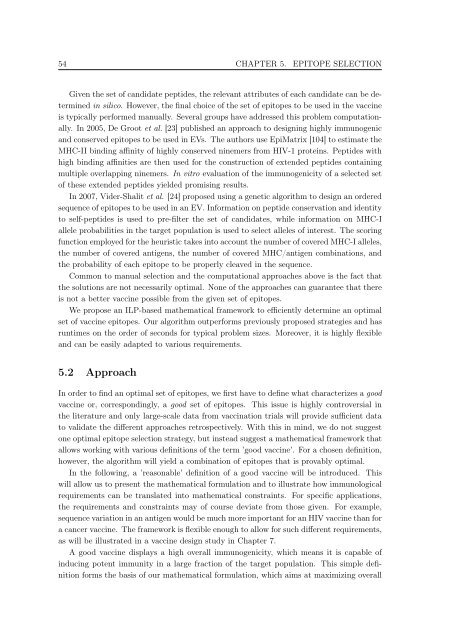New Approaches to in silico Design of Epitope-Based Vaccines
New Approaches to in silico Design of Epitope-Based Vaccines
New Approaches to in silico Design of Epitope-Based Vaccines
You also want an ePaper? Increase the reach of your titles
YUMPU automatically turns print PDFs into web optimized ePapers that Google loves.
54 CHAPTER 5. EPITOPE SELECTION<br />
Given the set <strong>of</strong> candidate peptides, the relevant attributes <strong>of</strong> each candidate can be determ<strong>in</strong>ed<br />
<strong>in</strong> <strong>silico</strong>. However, the f<strong>in</strong>al choice <strong>of</strong> the set <strong>of</strong> epi<strong>to</strong>pes <strong>to</strong> be used <strong>in</strong> the vacc<strong>in</strong>e<br />
is typically performed manually. Several groups have addressed this problem computationally.<br />
In 2005, De Groot et al. [23] published an approach <strong>to</strong> design<strong>in</strong>g highly immunogenic<br />
and conserved epi<strong>to</strong>pes <strong>to</strong> be used <strong>in</strong> EVs. The authors use EpiMatrix [104] <strong>to</strong> estimate the<br />
MHC-II b<strong>in</strong>d<strong>in</strong>g aff<strong>in</strong>ity <strong>of</strong> highly conserved n<strong>in</strong>emers from HIV-1 prote<strong>in</strong>s. Peptides with<br />
high b<strong>in</strong>d<strong>in</strong>g aff<strong>in</strong>ities are then used for the construction <strong>of</strong> extended peptides conta<strong>in</strong><strong>in</strong>g<br />
multiple overlapp<strong>in</strong>g n<strong>in</strong>emers. In vitro evaluation <strong>of</strong> the immunogenicity <strong>of</strong> a selected set<br />
<strong>of</strong> these extended peptides yielded promis<strong>in</strong>g results.<br />
In 2007, Vider-Shalit et al. [24] proposed us<strong>in</strong>g a genetic algorithm <strong>to</strong> design an ordered<br />
sequence <strong>of</strong> epi<strong>to</strong>pes <strong>to</strong> be used <strong>in</strong> an EV. Information on peptide conservation and identity<br />
<strong>to</strong> self-peptides is used <strong>to</strong> pre-filter the set <strong>of</strong> candidates, while <strong>in</strong>formation on MHC-I<br />
allele probabilities <strong>in</strong> the target population is used <strong>to</strong> select alleles <strong>of</strong> <strong>in</strong>terest. The scor<strong>in</strong>g<br />
function employed for the heuristic takes <strong>in</strong><strong>to</strong> account the number <strong>of</strong> covered MHC-I alleles,<br />
the number <strong>of</strong> covered antigens, the number <strong>of</strong> covered MHC/antigen comb<strong>in</strong>ations, and<br />
the probability <strong>of</strong> each epi<strong>to</strong>pe <strong>to</strong> be properly cleaved <strong>in</strong> the sequence.<br />
Common <strong>to</strong> manual selection and the computational approaches above is the fact that<br />
the solutions are not necessarily optimal. None <strong>of</strong> the approaches can guarantee that there<br />
is not a better vacc<strong>in</strong>e possible from the given set <strong>of</strong> epi<strong>to</strong>pes.<br />
We propose an ILP-based mathematical framework <strong>to</strong> efficiently determ<strong>in</strong>e an optimal<br />
set <strong>of</strong> vacc<strong>in</strong>e epi<strong>to</strong>pes. Our algorithm outperforms previously proposed strategies and has<br />
runtimes on the order <strong>of</strong> seconds for typical problem sizes. Moreover, it is highly flexible<br />
and can be easily adapted <strong>to</strong> various requirements.<br />
5.2 Approach<br />
In order <strong>to</strong> f<strong>in</strong>d an optimal set <strong>of</strong> epi<strong>to</strong>pes, we first have <strong>to</strong> def<strong>in</strong>e what characterizes a good<br />
vacc<strong>in</strong>e or, correspond<strong>in</strong>gly, a good set <strong>of</strong> epi<strong>to</strong>pes. This issue is highly controversial <strong>in</strong><br />
the literature and only large-scale data from vacc<strong>in</strong>ation trials will provide sufficient data<br />
<strong>to</strong> validate the different approaches retrospectively. With this <strong>in</strong> m<strong>in</strong>d, we do not suggest<br />
one optimal epi<strong>to</strong>pe selection strategy, but <strong>in</strong>stead suggest a mathematical framework that<br />
allows work<strong>in</strong>g with various def<strong>in</strong>itions <strong>of</strong> the term ’good vacc<strong>in</strong>e’. For a chosen def<strong>in</strong>ition,<br />
however, the algorithm will yield a comb<strong>in</strong>ation <strong>of</strong> epi<strong>to</strong>pes that is provably optimal.<br />
In the follow<strong>in</strong>g, a ’reasonable’ def<strong>in</strong>ition <strong>of</strong> a good vacc<strong>in</strong>e will be <strong>in</strong>troduced. This<br />
will allow us <strong>to</strong> present the mathematical formulation and <strong>to</strong> illustrate how immunological<br />
requirements can be translated <strong>in</strong><strong>to</strong> mathematical constra<strong>in</strong>ts. For specific applications,<br />
the requirements and constra<strong>in</strong>ts may <strong>of</strong> course deviate from those given. For example,<br />
sequence variation <strong>in</strong> an antigen would be much more important for an HIV vacc<strong>in</strong>e than for<br />
a cancer vacc<strong>in</strong>e. The framework is flexible enough <strong>to</strong> allow for such different requirements,<br />
as will be illustrated <strong>in</strong> a vacc<strong>in</strong>e design study <strong>in</strong> Chapter 7.<br />
A good vacc<strong>in</strong>e displays a high overall immunogenicity, which means it is capable <strong>of</strong><br />
<strong>in</strong>duc<strong>in</strong>g potent immunity <strong>in</strong> a large fraction <strong>of</strong> the target population. This simple def<strong>in</strong>ition<br />
forms the basis <strong>of</strong> our mathematical formulation, which aims at maximiz<strong>in</strong>g overall

















